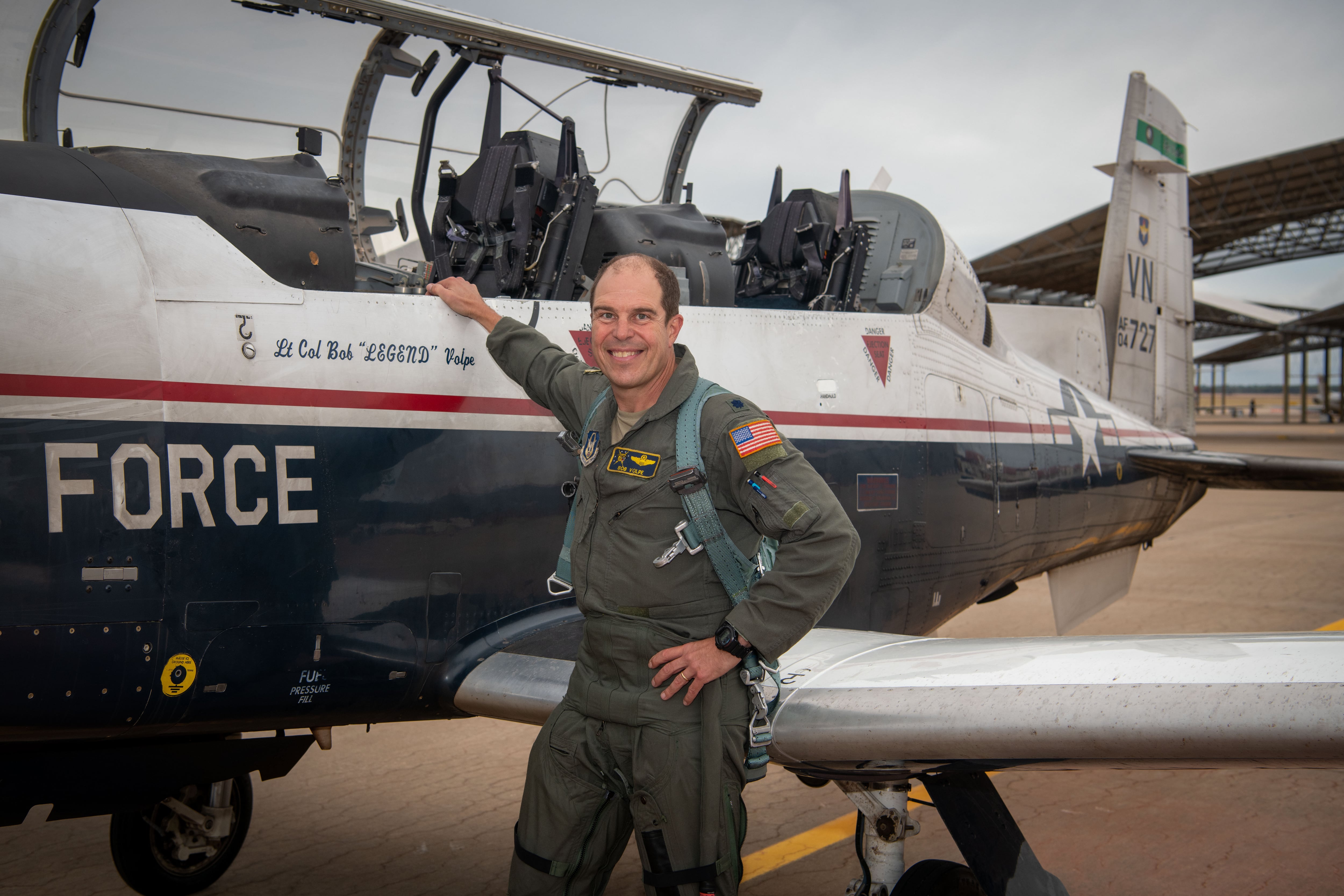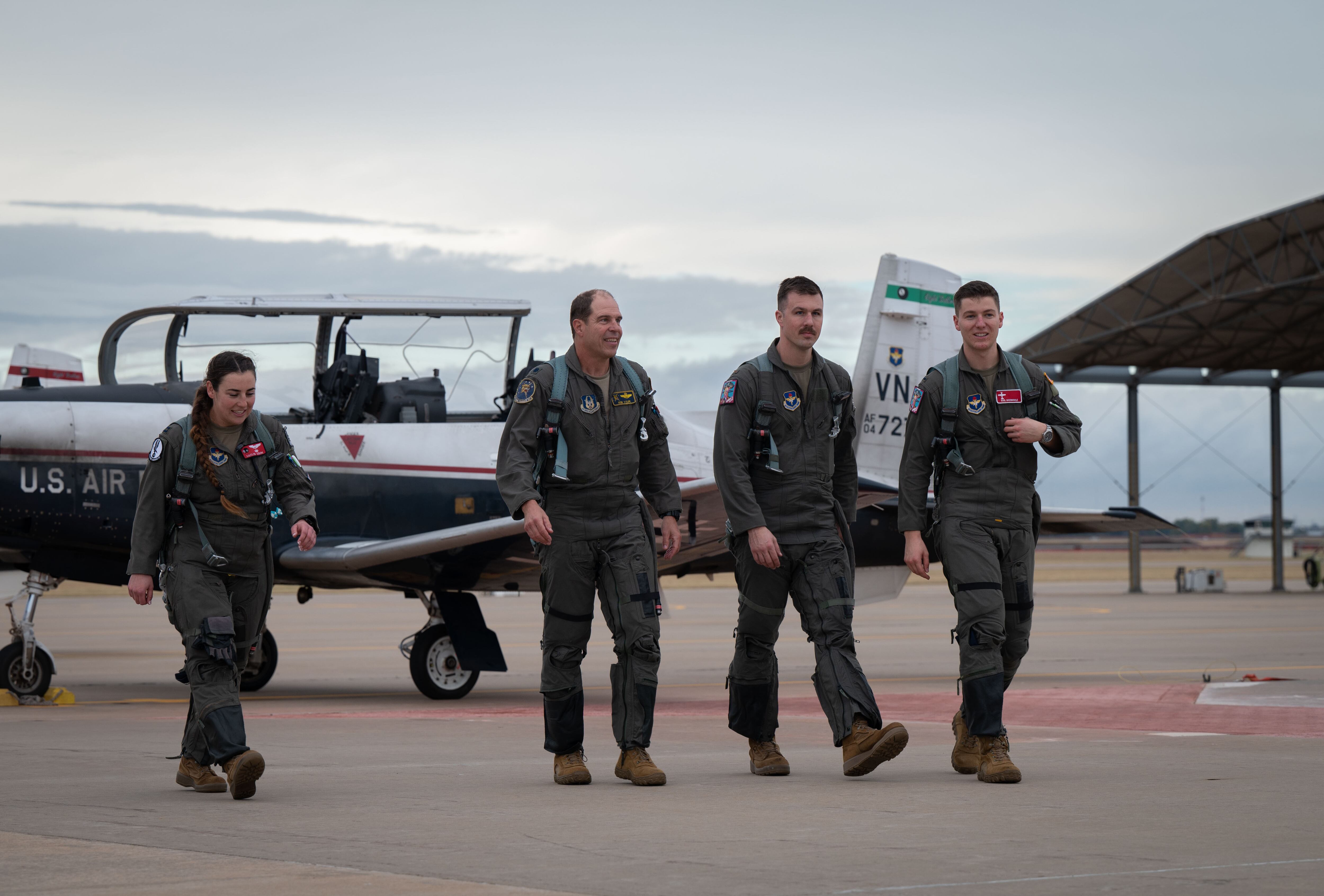Lt. Col. Bob “Legend” Volpe occupies rarified air.
On Oct. 25, Volpe, an Air Force Reserve instructor pilot at the 5th Flying Training Squadron at Vance Air Force Base, Oklahoma, reached a milestone the service says is very uncommon: 10,000 hours in the cockpit.
That’s more than double the hours logged by many four-star generals and higher than the past two Air Force chiefs of staff combined.
He got there through a combination of years in the Air Force Reserve, avoiding command jobs that would have taken him out of the cockpit and signing up for as many sorties as he could muster.
Volpe earned his commission through the Reserve Officer Training Corps in 1988 and graduated from pilot training at now-closed Reese Air Force Base, Texas, in 1990. He began his Air Force career as a T-38 Talon instructor pilot before switching gears to fly the C-130 Hercules. He later returned to teaching in the T-37 Tweet and T-6 Texan II trainers.
He spoke to Air Force Times Oct. 26 ahead of his retirement in April 2024. This conversation was edited for length and clarity.

Air Force Times: Why did you join the Air Force, and how did you make it to 10,000 flight hours?
Volpe: I joined the Air Force to fly. My dad, who was not a pilot, was a big airplane enthusiast. My whole career, my job has been just to fly airplanes. All but my C-130 time has been as an instructor pilot. In my younger years, I absolutely flew as much as I possibly could, balancing it with family life. Age takes its toll, so I slowed down a little bit as I turned 50, but now here in my last year, I’ve somehow managed to figure out how to pick it back up again. I knew that 10,000 would happen, but I’m not, honestly, chasing numbers. It’s just, I love what I do. I want to go out tired.
What went through your head when you hit that mark?
I wasn’t going to keep it a secret from anybody, but we’re getting pretty close to finishing a class. I wanted them to be part of that celebration. I [reached that milestone] with a student. It was a formation sortie. Then we had a good dinner with the instructors and the students. The day went perfect, other than weather. That’s the one thing I couldn’t control. Skies opened up, and then they closed again right after we landed. So it was perfect.
Is there anything that makes any part of those 10,000 hours stand out?
If you think about flying, or instructing how to fly, from the perspective of a 24-year-old, when I started, versus a 57-year-old — obviously, I’ve matured quite a bit. For every chapter of my life, the airframe I was flying, the students that we’re flying with, they all have their special memories. I go out now as more of a father figure, not just to students, but also to my fellow instructor pilots. I thoroughly enjoy what I do right now, and the relationship that I can have with these kids. I’ve flown with the sons of fellow pilot training classmates; former students. There’s an instructor pilot here whose dad was a student of mine when I was a first assignment instructor pilot (FAIP). When I meet a new class, I’ll ask, “Whose mom or dad was in the Air Force?” Surely somebody raises their hand, and our paths have crossed somehow.
What drew you to being an instructor pilot?
Like most people who get FAIP, it wasn’t my first choice. It was pretty far down on the list. But that was the best thing for me, because it made me realize that I love it. If I wasn’t a pilot, I always say I would be some form of teacher. I probably didn’t know that, either, until I started teaching. After three years in the C-130, I absolutely raised my hand to come back and teach.
How has your approach to pilot training evolved over the years?
I don’t think I’m ever on autopilot. We’re changing every day with technology and finding new ways in which the students can learn. My method in which I’ve taught students, I don’t think has changed in the 35 years I’ve been flying, because we’re still just teaching how to fly an airplane.
How has your time in the cockpit shaped how you think about the future of pilot training?
We’ve introduced a syllabus that was completely different from the syllabi that we’ve had in the past. We still produce the same product, we just use many different methods to produce it. This new syllabus — we just started flying on it within the past six months — it’s a little bit of a “back to the basics” approach, which is what I was hoping for. I’m happy that I get to leave the Air Force where there’s a syllabus that still addresses the fact that we have all this modern technology to work with, but we’re still teaching foundational [skills].
How has training new pilots differed in peacetime and wartime?
The Gulf War kicked off right after I finished pilot training in 1990. After that, my mentors were pilots that had returned from the Gulf War. The atmosphere, with that experience being so fresh, it was real. Now, sure, there’s things going on, but we don’t necessarily hear the stories or get the folks who have been through it.
What personal or professional hurdles have you overcome during your time in uniform?
When I say I didn’t want to be an instructor pilot — that’s always a challenge, when you have a dream and you’re not sure how that’s going to work out. I didn’t want the C-130 either. That was a big hurdle, how to motivate myself for an airframe or an assignment that I didn’t necessarily want. Because I didn’t get my first choice twice, it makes me such a better mentor when my students don’t get their first choice, because I’ve been there. I know they can’t see themselves in 30 years, but I never would have thought, as a 24-year-old, that I’d be doing what I’m doing at age 57 and how blessed and fortunate I am.
Which aircraft is your favorite?
I think each airplane was perfect for each phase of my life. The T-38 goes really fast, and as a young 20-something, it’s as close to being a fighter pilot as I would get. The T-37 can beat you down. I did that in my 30s. Super fun airplane to fly, but it was built in the 1950s. It’s unpressurized, no g-suit. I couldn’t fly it at my age. When the T-6 came on board, everybody was calling it the “gentleman’s airplane” because it’s got sheepskin seats. It’s getting pretty old now, but it’s pressurized. We wear g-suits. It’s a blast to fly, even at age 57. I don’t have a favorite, and I’m honestly not biased toward one or the other. Each one was special.
Do you have any flight rituals or traditions?
I put everything on the exact same way, every time. I don’t call it a superstition or a ritual. But I set up my cockpit the exact same way, with the exact same method and rhythm. Should anything be out of order, I take a step back and think, “OK, what’s going on here?”
Is there anything else you want to accomplish before you retire?
I have done so much. I have been able to fly all over the country. Pre-9/11, they would let you fly circles over [Washington]. It’s time. I’ll be 58 when I’m done. I can never say I’ve checked every box as a teacher, because I do think my relationship with my students will keep going. I will still be a mentor even as I grow old.
Rachel Cohen is the editor of Air Force Times. She joined the publication as its senior reporter in March 2021. Her work has appeared in the Washington Post, the Frederick News-Post (Md.), Air and Space Forces Magazine, Inside Defense, Inside Health Policy and elsewhere.





